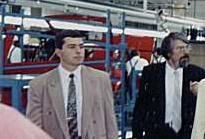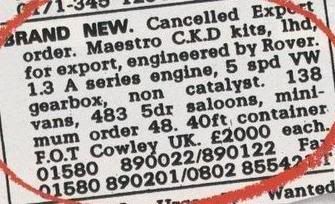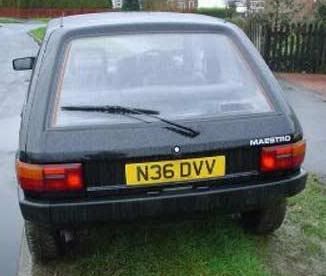|
Background
In the early 1990s, British car maker Rover Group Ltd, under British Aerospace management,
set their minds to build vehicles in Eastern Europe. Already, the region had been penetrated by
other western-car makers, such as Volkswagen and Ford, however through a process of elimination, Rover
Group set their sights on Bulgaria for vehicle production.
There was already history between Bulgaria and the UK company, in that they both had license
agreements with Perkins Engines. Rover also saw advantage in Bulgaria's highly skilled engineers and
cheap labour. It was at this time that Rover had ideas of shifting production of the Maestro from
Cowley to a location in Bulgaria.
Having shown this interest, Rover Group Ltd were approached with an offer of a joint venture by a
Bulgarian engineering company named Vammo, to which Rover promptly agreed. Their intended vehicle output
was around 7,500 Maestro cars by 1992 with the hope of producing up to 50,000 annually by 1994.
Rover were praised by the British press for their achievments, although it was to be short-lived, because
the negotiations with Vammo unexpectedly crashed. This was rumoured to have been due to a lack of approval by the
Bulgarian Ministry of Industry. Nevertheless, Rover continued in their search...
Rover and Daru Group Venture
In 1994, rival car builder BMW purchased the Rover brand from British Aerospace. Thus, the link was made between
Rover and the Daru Group, BMW's main dealer in Bulgaria. In this merge, named Rodacar AD, Rover held 51% ownership and
the Daru Group the other 49%.
A $20million investment was made to build a factory in Varna, on the East coast of Bulgaria, where the production line
was to be housed. The Rodacar plant was opened on 15th September 1995, by the President of Bulgaria, who was apparently
optimistic about the venture. Their intended output by the end of that year was 1,700 vehicles, then 7,000 in the following
year. Britain's press were again pleased by this venture and were hopeful of its future.
It is understood that the parts were produced in the UK by Rover and shipped to Bulgaria where the vehicles were
built up to a high standard. Their exact specification is described in the next section.

The opening of the Rodacar plant in Varna - Click for full image...
Photo C/O Austin-Rover.co.uk
Rodacar Maestros
Due to the intent of the vehicles being used in Bulgaria, all of the Maestros produced were in left hand drive (LHD) form.
Essentially, the cars are identical to the Clubman model of the Mk3 Maestro, produced between 1993 and 1995 in the UK.
There were, however, differences in specification, such as the lack of a sunroof, but primarily to suit the rough, hilly roads
of Bulgaria.
Firstly, attached to the A+ series engine, is a close-ratio five speed VW gearbox as used on the Maestro van, specified to deal with
the hilly roads.
Where the last of the Maestros in the UK were legally obliged to be fitted with catalytic converters as standard, this was
not an issue in Bulgaria, so the normal three piece exhaust system was used*.
Also to cope with Bulgaria's roads, the Maestros were fitted with the suspension units and 14" steel wheels as used on the 2.0 Diesel
Rover Maestro. With the A series engine being lighter than the Perkins diesel unit, this makes for an interesting ride-height,
especially at the front end.
The choice of colours available with these Maestros were: Diamond White, Flame Red, Midnight Blue and Black.
The End of Maestro Production
Fast forward half a year, to April 1996. It was announced that Rodacar would cease producion of the Maestro after only 2,000 vehicles
were produced. The main reason for this abrubt hault is said to be a lack of approval once again on the Bulgarian part. This could well
be linked with the apparently high import/tax costs of importing the vehicle components from Rover in the UK.
There was also little demand for the cars, Rodacar having only sold 200 vehicles in seven months. This is apparently due to other vehicles,
such as Skoda Felicias and Fiats, being cheaper to acquire, possibly as a knock-on effect of the high parts import costs and subsequent high purchase cost
of the Maestro. It is not known, however, the cost at which the cars were being sold.
Rodacar Maestros in the UK
Of the (+-)2,000 vehicles produced, only around ten per cent were apparently sold in Bulgaria. A further one thousand or so were distributed to other countries,
including Serbia and areas in South America. The remaining vehicles were returned to the UK...

Car, Feb 1997 - Click image for full article...
> Parkway Services, Ledbury, Herefordshire
The article above, found in February 1997 issue of Car, advertises 621 uncomplete Maestro cars and vans. Parkway Services acquired the whole batch in kit form, from their storage at Cowley, Oxfordshire. These parts were surplus to requirement once the Rodacar plant closed.
Parkway's objective was to build up the vehicles, at the same time converting them to right hand drive for use in Britain. RHD parts were acquired from Rover and other sources for this project, which commenced in late 1997 and finished in 2001.
Once completed, the vehicles had non-Rover chassis numbers etched into their VIN plates and front suspension turrets, before they were registered as kit cars. As a result, the Maestros sold 'new' by Parkway Services at a cost of £4,995, were registered on R, S, T, V, W, X, Y and 51 numberplates.
These vehicles, classed as kit cars, can attract slightly higher insurance premiums as a result. They are also 'exempt' from both the non-catalyst
and catalyst emissions tests at MoT. Instead, they undergo a 'visual' emissions test only.
> Apple 2000 Ltd, Bury St. Edmunds, Suffolk
Apple 2000 acquired a much smaller batch of new Maestros from Alstone Marketing in 1999. These vehicles had been completed in Bulgaria and as such were given
Rover chassis numbers. The first build number on record is at least 100,000 greater than that of the 'Last of the Line' UK Rover Maestro, perhaps for differenciating.
Many of the cars supplied by this company were converted to RHD before being sold at a cost of £4,500 (or £4,995 with warranty). It is noted, however,
that many of the converted cars retained LHD wiper and mirror setup. A minority of the cars were kept in LHD form (possibly for export purposes) and as such were sold
for around £3,995.
Because these vehicles had been completed in 1995/6, the majority recieved 'N' prefix, Bury St. Edmunds registrations. Speaking to the manager of Apple 2000
revealed that at least one Maestro was fitted with a catalytic converter and registered on an 'X' prefix.
These cars, registered with the 1995/6 'N' prefix, are exempt from the MoT emissions test of that year, because they were legally built without a catalytic converter
being fitted (Bulgarian legislation).

A Suffolk-registered 'Apple 2000' Maestro
References
Links:
Unofficial Austin-Rover Resource - Rodacar article by Kieth Adams
Maestro & Montego Owners Club - Ledbury & Apple 2000 Maestro article
Anatomy of a Business Failure - A report on the Rover/Daru Group venture
|







